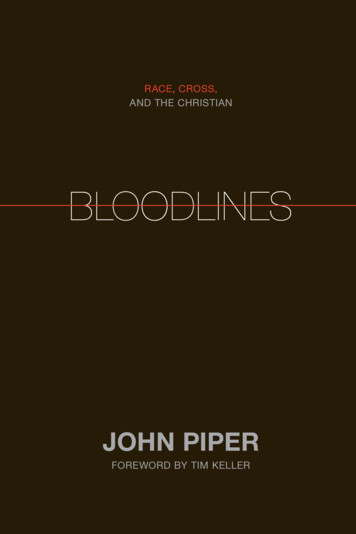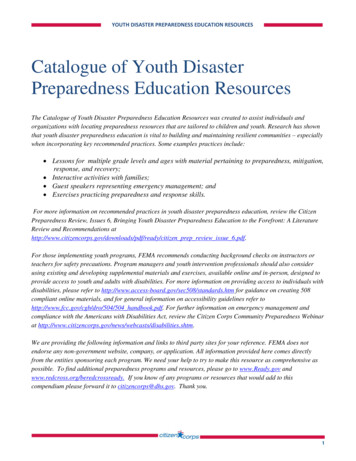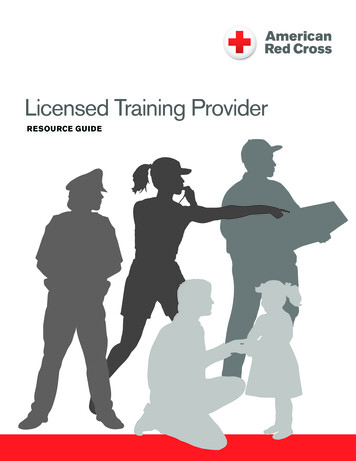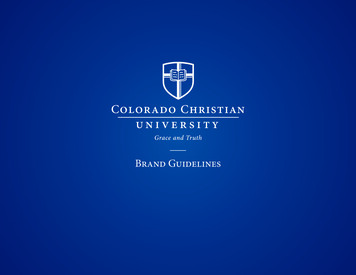
Transcription
JOHN PIPERRACE, CROSS,AND THE CHRISTIANBLOODLINESBO LN SJOHN PIPERFOREWORD BY TIM KELLER
“Americans have been turning to organizations, education, famouspersonalities, and ultimately government in an effort to address theongoing racial strife in our nation. In 2008 many hoped the election ofan African-American president would finally bridge the racial divide.Today, we are left wondering why racial tensions have not abated. JohnPiper argues from specific biblical texts that the only solution powerfulenough to overcome racial strife and bring about reconciliation and harmony is the gospel of Jesus Christ. It is this gospel that announces that,through his blood, Jesus has demolished the dividing wall that separateshumanity along racial lines and has brought all ethnicities together asbrothers and sisters into one body—the church. Yet Piper does not endthere. He carefully shepherds us through the various implications of thegospel in relation to race and ethnicity. In this sense, the book you holdin your hands is so much more than a book about race and ethnicity.Bloodlines is a prime example of how we are to do the hard work ofrenewing our minds by replacing old ways of thinking with gospel waysof thinking. Read this book and let it serve as a model of how to prepareyour mind for action and to think soberly about God, your sin, Christ,the gospel, and one another for the sake of your soul, Christ’s church,and God’s glory.”Juan R. Sanchez Jr., Preaching Pastor, High Pointe BaptistChurch, Austin, Texas“John Piper has given us an exquisite work on the matter of race. Headdresses the issue with biblical and theological soundness coupled withpersonal sensitivity and practical advice. This is a must read for thosewho wish to pursue unity God’s way.”Tony Evans, President, The Urban Alternative; Senior Pastor,Oak Cliff Bible Fellowship“For years, I have yearned for a biblically sound, theologically anchoredresource on race. God has answered that prayer. Leaping off the pages ofBloodlines is the power of the gospel to overcome and defeat racism anda call to cross-centered, holy justice in our attitudes and actions towardthose who are not like us. This is an important, foundational work, andI am sure it will be used of God to remind all of us of the power andprecious, priceless dignity of the gospel.”Crawford W. Loritts Jr., author; speaker; radio host;Senior Pastor, Fellowship Bible, Roswell, Georgia
“Piper bequeaths an outstanding—and at times, risky—work on raceand ethnicity, thoroughly soaked in the biblical Christian Hedonismworldview. I found that Piper’s personal testimony from the 1960s untilnow and his exploration of African-American writers past and present demonstrate the complexity of dealing honestly with the topic forthose who seek to honor the Savior. He is right: on race, ‘we have fallentogether.’ The only question that remains is whether or not individualmembers of the church will take deeply to heart this sincere analysis ofthe cross of Christ and race and then become a steadfast holy force forundoing the problems of racism in the world.”Eric C. Redmond, author, Where Are All the Brothers?Straight Answers to Men’s Questions about the Church;council member, The Gospel Coalition
BLOODLINES
Other Crossway Books by John PiperWhat’s the Difference?A Hunger for GodGod’s Passion for His GloryThe InnkeeperSeeing and Savoring Jesus ChristThe Legacy of Sovereign JoyThe Hidden Smile of GodCounted Righteous in ChristThe Misery of Job and the Mercy of GodThe Roots of EnduranceDon’t Waste Your LifeFifty Reasons Jesus Came to DieThe Prodigal’s SisterWhen I Don’t Desire GodGod Is the GospelWhat Jesus Demands from the WorldWhen the Darkness Will Not LiftContending for Our AllThe Future of JustificationSpectacular SinsThis Momentary MarriageFilling Up the Afflictions of ChristJohn Calvin and His Passion for the Majesty of GodVelvet SteelRuthSweet and Bitter ProvidenceThink
BLOODLINESRACE, CROSS, AND THE CHRISTIANJOHN PIPERFOREWORD BY TIM KELLERW H E AT O N , I L L I N O I S
Bloodlines: Race, Cross, and the ChristianCopyright Desiring God FoundationPublished by Crossway1300 Crescent StreetWheaton, Illinois 60187All rights reserved. No part of this publication may be reproduced, stored in aretrieval system, or transmitted in any form by any means, electronic, mechanical,photocopy, recording, or otherwise, without the prior permission of the publisher,except as provided for by USA copyright law.Cover design: Josh DennisFirst printing 2011Printed in the United States of AmericaUnless otherwise indicated, Scripture quotations are from the ESV Bible (TheHoly Bible, English Standard Version ), copyright 2001 by Crossway. Used bypermission. All rights reserved.Scripture quotations marked kjv are taken from the King James Version of theBible.Scripture quotations marked nasb are from The New American Standard Bible .Copyright The Lockman Foundation 1960, 1962, 1963, 1968, 1971, 1972,1973, 1975, 1977, 1995. Used by permission.All emphases in Scripture quotations have been added by the author.Hardcover ISBN: 978-1-4335-2852-1PDF ISBN: 978-1-4335-2853-8Mobipocket ISBN: 978-1-4335-2854-5ePub ISBN: 978-1-4335-2855-2Library of Congress Cataloging-in-Publication DataPiper, John, 1946–Bloodlines : race, cross, and the Christian / John Piper ; forewordby Tim Keller.p. cm.Includes bibliographical references and index.ISBN 978-1-4335-2852-1 (hc)1. Reconciliation—Religious aspects—Christianity. 2. Racediscrimination—Religious aspects—Christianity. 3. Church andminorities. I. 10732Crossway is a publishing ministry of Good News 11
ToTalitha RuthDaughter by love and law,sister in the Great Bloodline
CONTENTSForeword by Tim Keller11Preface13A Note to the Reader on Race and Racism17PA R T O N EOUR WORLD: THE NEED FOR THE GOSPELIntroductionMartin Luther King Jr.: What Was It Like for Those WhoWeren’t There?23SECTION ONEMy Story, My Debt, My World: Why I Wrote the Book1My Story: From Greenville to Bethlehem312The Gospel I Love, the Debt I Owe, and the Church I Serve433Global Shifting and the New Face of the Church51SECTION TWOBlack and White and the Blood of Jesus4 Why This Book Gives Prominence toBlack-White Relationships595Personal Responsibility and Systemic Intervention716The Power of the Gospel and the Roots of Racial Strife87PA R T T W OGOD’S WORD: THE POWER OF THE GOSPELIntroductionWilliam Wilberforce: The Importance of Doctrine and“Coronary” Commitment109SECTION ONEThe Accomplishment of the Gospel7The Mission of Jesus and the End of Ethnocentrism1158The Creation of One New Humanity by the Blood of Christ121
9Ransomed for God from Every Tribe12910Every People Justified the Same Way147SECTION TWOThe Application of the Gospel11Dying with Christ for the Sake of Christ-Exalting Diversity15912Living in Sync with Gospel Freedom16913The Law of Liberty and the Peril of Partiality181SECTION THREEThe Ultimate Goal of the Gospel14Why Is It Worth the Death of His Son?193SECTION FOURTwo Issues: Interracial Marriage and Prejudice15Interracial Marriage20316Probability, Prejudice, and Christ217Conclusion: Confession, Warning, Plea227APPENDICESAppendix 1: Is There Such a Thing as Race?A Word about Terminology234Appendix 2: The Sovereignty of God and the Soul Dynamic:241God-Centered Theology and the Black Experience in AmericaAppendix 3: How and Why Bethlehem Baptist Church PursuesEthnic Diversity256Appendix 4: What Are the Implications of Noah’s Curse?263Notes268Subject Index281Name Index285Scripture Index289Desiring God: A Note on Resources295
FOREWORDI was excited when I learned that John Piper was writing a book on raceand the gospel of the cross. When John gave me the privilege of readingthe manuscript, I devoured it and found that despite my high expectations I was not disappointed. It was helpful to me personally, helpful tome theologically (in understanding the relevance of the gospel to racialconflict), and it was especially encouraging to me to think that many inthe evangelical world would read it.John and I are both old enough to remember the complicity ofevangelical churches and institutions with the systemic racism in the USbefore the civil rights movement. I took my first church in a small townin the South in the early 1970s. The courts had recently ruled that thewhites-only public swimming pool, operated by the town with taxpayers’ money, had to be integrated. So what did the town do? It shut thepool down completely, and the white people of the town opened a newprivate swimming pool and club, which of course, did not have to admitracial minorities. Because I was a young pastor, our family was ofteninvited to swim there, and swim we did, not really cognizant of whatthe pool represented.One of the reasons I think this book is so important is that conservative evangelicals (particularly white ones) seem to have become moreindifferent to the sin of racism during my lifetime. Why? One reason,of course, is the stubbornness of the sinful heart. We never want to hearabout what is wrong with us. Another factor may be cultural. Manyhave made racism and prejudice virtually the only thing they will stillcall a “sin,” and they often lay the guilt for the sin of racism at the doorstep of those who are social conservatives. Because of that, many whoidentify themselves as conservatives simply don’t want to hear aboutracism anymore. They give lip service to it being a sin, but they associateany sustained denunciation of racism with the liberal or secular systemsof thought. John’s book, which you have in your hands, is a strong anti11
FOREWORDdote to this misconception. His motivation is simply as a preacher of theWord to bring to light what God says in it regarding race and racism.There are many ways in which this book will help the church in itsstruggle with the sin of racism. First, John takes us to all the biblicaltexts that speak most directly to the subject of race. But—and this wasmost helpful to me—John does not stop there. He then goes to most ofthe central doctrines and themes of our faith and shows the implicationsof each one for our understanding of race. He demonstrates how Jesus’sproclamation of the kingdom, his substitutionary atonement, the doctrine of conversion, of union with Christ, of justification by faith—alltransform our attitude toward our own race and culture as well as tothose belonging to other races and cultures.I won’t ever forget how one of the elders in my first church, whohad been growing in his understanding of the gospel and of the cross ofJesus, said to me, “You know, I realize I’ve been a racist all my life.” Ihadn’t spoken to him of racism at all, but as he was going deeper intothe theology of grace, he connected the dots for himself. I must say thatmost of us are not that insightful, and that’s why we need this volume.Let John Piper connect the dots for you.Tim KellerFebruary 201112
PREFACEAs I prepare to send Bloodlines into a world of ethnic and racial discord,I thank God that he has spoken. We are not left to ourselves. We humanshave never had the resources in ourselves to love each other well acrossethnic lines. There is too much selfishness in all of us.But God has told us what we must do. And he has sent his Son,Jesus Christ, to do what we can’t and to give us new power to do whatwe must. His death for us, and his Spirit in us, can make a world ofdifference.God has told us not to murder (Ex. 20:13). He has told us to loveour neighbor as ourselves (Lev. 19:18; Gal. 5:14)—including the neighbor who is an enemy (Matt. 5:44). He has told us to do good to everyone(Gal. 6:10)—including those who hate us (Luke 6:27). He has told us tobe peacemakers (Matt. 5:9) and to treat others the way we would liketo be treated (Matt. 7:12).He has revealed to us that every human is created in the image ofGod (James 3:9). He has shown us that we all have the same humanfather and are therefore kinsmen by blood (Acts 17:26). And he hasmade clear that, when his Son died on the cross for our sins, he “ransomed people for God from every tribe and language and people andnation” (Rev. 5:9). Racial harmony is a blood issue, not just a socialissue.God has spoken. And he has acted. He has entered our world inthe person of his Son. His word, his action, and his incarnation are theend of ethnic arrogance for those who embrace him as the Treasure oftheir lives.* * *The bloodline of Jesus Christ is deeper than the bloodlines of race. Thedeath and resurrection of the Son of God for sinners is the only suffi13
PREFACEcient power to bring the bloodlines of race into the single bloodline ofthe cross.* * *Therefore, this book has a center. It has a heart. If I had to boil it down,I would send you to chapters 6, 9, 15, and the conclusion. But heartsdon’t exist without bodies. And so the rest of the book matters.I tell my sad and thankful story in chapters 1 and 2 and set the stageglobally in chapter 3. In chapter 4 I explain why black-white relationsget prominence, when the contemporary picture of diversity is far morecomplex. Chapter 5 takes me in over my head to the complexities ofpersonal and structural causes for race-related disadvantages. But betterto aim at understanding and fall short than to surrender at the outset.Chapter 6 is the center, where the gospel shines as the God-givenremedy for ten deadly realities that lie at the root of racial strife.Chapters 7–14 give the biblical exposition that lies at the foundationof everything else. Chapter 15 tackles the issue of interracial marriage,which I think is still just beneath the surface of many racial tensions.And chapter 16 wrestles with the inevitability and necessity of formingpre-judgments and how they relate to negative prejudices.* * *Now there are stories to tell, and problems to solve, and complexities toponder, but in the end the good news of what Jesus has done, in dyingand rising again to bear our sins and bring us to God, will make all thedifference. Only Jesus can bring the bloodlines of race into the singlebloodline of the cross and give us peace. Everything was made throughhim and for him (Col. 1:16). Therefore he will get the glory for this too.“All the families of the nations shall worship before [him]” (Ps. 22:27).* * *I am thankful to my wife, Noël, and daughter, Talitha, for the supportthey have been to me during the writing of this book. Again the eldersof our church have made this book possible by giving me a writing leave14
PREFACEeach year, and even a few extra days this time, because of the unusualchallenges of this book. David Mathis, my fellow elder and executivepastoral assistant, along with Nathan Miller, has managed my life forme, and provided innumerable helps that freed me to do this kind ofthinking and writing. Finally, the people of Bethlehem—the flock I loveto feed—have been a joy to serve. Without their peace and partnership,I could not flourish in the ministry. God has been good to me.John PiperMinneapolis, MinnesotaMaundy Thursday 201115
A NOTE TO THE READER ONRACE AND RACISMI’m a stickler for clear definitions. I like to know what I am talkingabout. If you would rather just pick up my meaning as you go along,feel free to skip this section and go straight to the introduction. Storiesare always more interesting.Believe it or not, the existence of the reality of race itself is disputed.I mean seriously by very wise people whom I admire. I deal with this inappendix 1. And, of course, the term racism is ambiguous as well.It seems to me that it is a healthy sign to wish that the term racedid not exist. It has not served well to enhance human relations. As weuse it, it is not a biblical category. We may not be able to communicatein our day without the term, but we can at least try to show why it’s afuzzy term that has often been hijacked by ideology for racist purposes.RACE IS MORE COMPLEX THAN COLOR—BUTNOT LESSNevertheless, in this book I have not tried to abandon the terms raceand racial. As loaded as the terms are, they are too embedded in ourlanguage and in the thousands of books and articles and sermons andlectures and conversations that make up the world we must relateto. There is no escaping this historically, and, in the present day, theproblems we face are conceived along racial lines understood mainlyas color lines.For example, in 1899 W. E. B. Du Bois delivered a speech to theFirst Pan-African Conference at Westminster Hall, London, and beganlike this:The problem of the twentieth century is the problem of the color line,the question as to how far differences of race—which show themselves chiefly in the color of the skin and the texture of the hair—will17
NOTE TO THE READERhereafter be made the basis of denying to over half the world the rightof sharing to their utmost ability the opportunities and privileges ofmodern civilization.1I will not begrudge Du Bois the use of the term race in this sense. Thisis history. And it is still the way the race issue is powerfully formulatedtoday. Unless I explicitly differentiate race and racial from ethnicity andethnic, I would like you, the reader, to think of both when I mentioneither—that is, ethnicity with a physical component and race with acultural component. Very often I use the terms together to draw out thiscombination of ideas.RACISM VALUES ONE RACE OVER ANOTHERWith regard to the term racism, it is possible to get oneself tied in somany knots that it feels hopeless to define. Several years ago, we spentmonths as a pastoral staff at our church trying to come up with aworking definition. I never thought defining a single word could be sodifficult. But I am simply going to cut the knot with a decision to workwith someone else’s definition.In the summer of 2004, the Presbyterian Church in America settledon the following definition, which I find helpful: “Racism is an explicitor implicit belief or practice that qualitatively distinguishes or valuesone race over other races.”2 In spite of saying above that I usually usethe term race with cultural connotations (ethnicity), in this definition Iam thinking of race primarily in terms of physical features. I am makinga distinction between race and ethnicity.The reason is that, since ethnicity includes beliefs and attitudes andbehaviors, we are biblically and morally bound to value some aspectsof some ethnicities over others. Where such valuing is truly rooted inbiblical teaching about good and evil, this should not be called racism.There are aspects of every culture, including our own (whoever “our”is), which are sinful and in need of transformation. So the definition ofracism here leaves room for assessing cultures on the basis of a biblicalstandard.The focus of this definition of racism is on the heart and behavior ofthe racist. The heart that believes one race is more valuable than another18
NOTE TO THE READERis a sinful heart. And that sin is called racism. The behavior that distinguishes one race as more valuable than another is a sinful behavior. Andthat sin is called racism. This personal focus on the term racism does notexclude the expression of this sin in structural ways—for example, lawsand policies that demean or exclude on the basis of race. (See chapter 5where I focus on the issue of structural racism.)19
PART ONEOUR WORLD:THE NEEDFOR THE GOSPEL
INTRODUCTIONMARTIN LUTHER KING JR.What Was It Like for Those Who Weren’t There?A book on race written by a baby boomer,1 who came of age in the1960s, has to begin with the civil rights movement. It still grips us,defines us, in so many ways. After slavery itself and the Civil War, noevent or movement in the last four hundred years has affected the racialclimate in America today more than this movement. Things were doneand said in those days that need to be known by those who weren’tthere. The most eloquent spokesman of the movement was MartinLuther King Jr. His vision and his description of the situation that gaverise to the movement help explain why this book exists—especially part1, “Our World: The Need for the Gospel.”THE LEADERMartin Luther King Jr. was born January 15, 1929. On April 4, 1968,at 6:00 p.m., just outside Room 306 of the Lorraine Motel in Memphis,Tennessee, the thirty-nine-year-old King stood by the railing looking outover some rundown buildings just beyond Mulberry Street. James EarlRay took aim with a .30 caliber rifle and blew away the right side ofKing’s face and neck. He was pronounced dead at St. Joseph’s Hospitalan hour and five minutes later. The nonviolent voice against the rage ofracism was gone.Why would a thirty-nine-year-old man be killed? We need to teachour children this history. Some of us lived it and will never forget it.Segregation was the world we grew up in—legally mandated separationof races at all kinds of levels. Separate schools, separate motels, separaterestrooms, separate swimming pools, separate drinking fountains. Howcould you more clearly communicate the lie that being black was like23
OUR WORLD: THE NEED FOR THE GOSPELa disease. It had an unbelievably oppressive and demeaning effect onthe African-American community. And it had a deadening and defilingeffect on the conscience of the white community.King did not spark the movement. He was swept into it, almostagainst his will. The civil rights movement had many catalysts. One ofthe most important happened on May 17, 1954. That was the day thatthe Supreme Court decided the case called Brown v. Board of Education.It declared that state-imposed segregation in the public schools was aviolation of the Fourteenth Amendment. Many scholars say that “Brownremains the most important Supreme Court decision in [the twentieth]century.”2 Some of us would say that the 1973 Roe v. Wade was equallyimportant, only for opposite reasons. Brown tried to restore rights to anoppressed group. Roe v. Wade took rights away from an oppressed group.Another catalyst happened about a year and a half later. OnDecember 1, 1955, a forty-two-year-old black woman named RosaParks (who died October 24, 2005) refused to surrender her seat to awhite man on an officially segregated bus in Montgomery, Alabama.The black community of Montgomery rallied behind her when shewas put in jail. They boycotted the buses for 381 days. The leader ofthe movement—by no choice of his own—was the twenty-six-year-oldpastor of Dexter Avenue Baptist Church, the Reverend Martin LutherKing Jr. And with that leadership, he became the unrivaled leader of themovement until his death thirteen years later. No one spoke in that causewith more influence.“THE MOST ELOQUENT AND LEARNEDEXPRESSION”Martin Luther King called for freedoms and rights and justice thatwere long overdue. And he did it with an appeal to historic Christianvision, with amazing rhetorical skill, without condoning violence, andwith unprecedented and lasting success. That’s why there is a holidayin his honor. One of his writings in particular provides a window onthe mid-twentieth-century world of black Americans—“Letter fromBirmingham Jail.”The place is Birmingham, Alabama. The time is April 11, 1963. Iwas seventeen years old in Greenville, South Carolina. At the Gaston24
INTRODUCTIONMotel, Room 30, Martin Luther King, Ralph Abernathy, Wyatt Walker,and Fred Shuttlesworth decided to lead a peaceful, nonviolent demonstration the next day, Good Friday, against the racial injustices of thecity.As in most Southern cities in those days (including the one I wasgrowing up in 350 miles away) bus seating was segregated; schools,parks, lunch counters, restrooms, drinking fountains—they were almostall segregated. Some called Birmingham the most segregated city inthe country. Its bombings and torchings of black churches and homeshad given it the name “Bombingham”—and “the Johannesburg of theSouth.”There was one catch. The sheriff, Bull Connor, had served MartinLuther King with a state-court injunction that prohibited him and othermovement leaders from conducting demonstrations. With a wife andfour children back home in Atlanta, King decided to violate the injunction, pursue a peaceful, nonviolent demonstration, and willingly go tojail. On Good Friday, King led his fifty volunteers downtown, up to thepolice line, came face-to-face with Connor, and knelt down with RalphAbernathy in prayer. He and all the demonstrators were thrown intopaddy wagons and put in jail.On Tuesday, April 16, King was shown a copy of the BirminghamNews, which contained a letter from eight Christian and Jewish clergymen of Alabama (all white), criticizing King for his demonstration.In response, King wrote what has come to be called “Letter fromBirmingham Jail” and which one biographer described as “the mosteloquent and learned expression of the goals and philosophy of thenonviolent movement ever written.”3WHAT IT WAS LIKE—FOR THOSE WHOWEREN’T THEREWe need to hear the power and insight with which King spoke to mygeneration in the sixties—enraging thousands and inspiring thousands.The white clergy had all said he should be more patient, wait, and notdemonstrate. He wrote:25
OUR WORLD: THE NEED FOR THE GOSPELPerhaps it is easy for those who have never felt the stinging darts ofsegregation to say, “Wait.” But when you have seen vicious mobslynch your mothers and fathers at will and drown your sisters andbrothers at whim; when you have seen hate-filled policemen curse,kick, and even kill your black brothers and sisters; when you see thevast majority of your 20 million Negro brothers smothering in anairtight cage of poverty in the midst of an affluent society;. . . when you suddenly find your tongue twisted and your speechstammering as you seek to explain to your six-year-old daughter whyshe cannot go to the public amusement park that has just been advertised on television, and see tears welling up in her eyes when she’s toldthat Funtown is closed to colored children, and see ominous cloudsof inferiority beginning to form in her little mental sky, and see herbeginning to distort her personality by developing an unconsciousbitterness toward white people;. . . when you have to concoct an answer for a five-year-old sonwho is asking, “Daddy, why do white people treat colored people somean?”; when you take a cross-country drive and find it necessary tosleep night after night in the uncomfortable corners of your automobile because no motel will accept you; when you are humiliated day inand day out by nagging signs reading “white” and “colored”; whenyour first name becomes “Nigger,” your middle name becomes “Boy”(however old you are) and your last name becomes “John,” and yourwife and mother are never given the respected title “Mrs.”;. . . when you are harried by day and haunted by night by thefact that you are a Negro, living constantly at tiptoe stance, neverquite knowing what to expect next, and are plagued with inner fearsand outer resentments; when you are forever fighting a degeneratingsense of “nobodiness”—then you will understand why we find it difficult to wait. There comes a time when the cup of endurance runsover, and men are no longer willing to be plunged into the abyss ofdespair. I hope, sirs, you can understand our legitimate and unavoidable impatience.4To the charge that he was an extremist, he responded like this:Was not Jesus an extremist for love: “Love your enemies, bless themthat curse you, do good to them that hate you, and pray for themwhich despitefully use you, and persecute you”? Was not Amos anextremist for justice: “Let justice roll down like waters and righteousness like an ever-flowing stream”? Was not Paul an extremist for theChristian gospel: “I bear in my body the marks of the Lord Jesus”?26
INTRODUCTIONWas not Martin Luther an extremist: “Here I stand; I cannot dootherwise, so help me God”? And John Bunyan: “I will stay in jailto the end of my days before I make a butchery of my conscience.”And Abraham Lincoln: “Thus this nation cannot survive half slaveand half free.” And Thomas Jefferson: “We hold these truths to beself-evident, that all men are created equal . . . ” So the question is notwhether we will be extremist, but what kind of extremist we will be.Will we be extremists for hate or for love?5And finally he delivered a powerful call to the church, which rings astrue today as it did in 1963:There was a time when the church was very powerful—in the timewhen the early Christians rejoiced at being deemed worthy to sufferfor what they believed. In those days the church was not merely athermometer that recorded the ideas and principles of popular opinion; it was a thermostat that transformed the mores of society. . . .But the judgment of God is upon the church [today] as never before.If today’s church does not recapture the sacrificial spirit of the earlychurch, it will lose its authenticity, forfeit the loyalty of millions, andbe dismissed as an irrelevant social club with no meaning for the 20thcentury.6That is Martin Luther King’s prophetic voice ringing out of theBirmingham jail in 1963.HOW MUCH HAS CHANGED IN THE HEART?Many things have changed since 1963. And some deep things havenot changed. Let me illustrate. There are probably more vicious whitesupremacists in America today than there were in 1968. The victimsare as likely to be Latinos or Somali immigrants as African Americanswhose ancestors have been here for centuries. The Ku Klux Klan has nocorner on hate any more.On June 7, 1998—that’s ’98, not ’68—outside Jasper, Texas, JamesByrd, a forty-nine-year-old African American, was beaten and chainedby his ankles to the back of a pickup truck and dragged two miles untilhis head ripped off. The perpetrators had racist tattoos, one of themdepicting a black hanging from a tree. Many things have changed in the27
OUR WORLD: THE NEED FOR THE GOSPELlast forty years, but in some people some deep things haven’t changed.There is still plenty of
Bloodlines is the power of the gospel to overcome and defeat racism and a call to cross-centered, holy justice in our attitudes and actions toward those who are not like us. This is an important, foundational work, and . PDF ISBN: 978-1-4335-2853-8 Mobipocket ISBN: 978-1-4335-2854-5File Size: 2MB










